

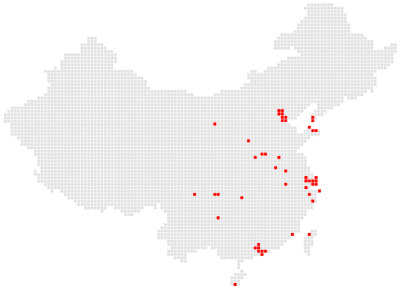


 Todao Ando, Japanese pavilion for EXPO '92, Sevilla, Spain
Todao Ando, Japanese pavilion for EXPO '92, Sevilla, Spain
 [via abbs]
[via abbs]
Comment by Yan known as ID Bendangwuren on ABBS
The competition of the pavilion undoubtly results in a typical Chinese way. As a citizen, maybe we could just think this as clownery and have fun.
For me, the most important focus is not about which real project did Mr He Jingtang copy from. Actually, he might willing to think about what is the tradition of China to be represented as the Government asked for. He also want to escape from the symbolic way of representing Chinese culture. By merging contemporary material and way of constructiong, he did this. (Although the name is Crown of the East, the original idea is to build a morden appearance of Dou Gong (corbel bracket). Ironically, the abstraction of traditional wood structure of China leads to an Japanese sytle inevitably. Wow, maybe Mr He himself didnt aware of that. Isn't true that Japanese people copied Chinese stuffs long long time ago, then made them into more abstract and practical way, which is now widely known as JANPANESE STYLE? Like karate is a typical Japanese kongfu which is copied from Chinese kongfu by simplifing all the looking-good techniques.
Till now, could we say that when we Chinese want to explain our tradition in modern western way (since we are also in modernizing by the western techonology and culture), we suddenly find that our neighbor Japan has already done that in very mature and successful way, plus, this has been known widely as Japanese tradition for the world. Thus, could we still boost this as our tradition by only symbolize the traditional Chinese style? What is the real tradition we had before, and what is we still have now? The issue becomes is the image of old China is the tradition or is the way of represetation means the traditional thinking of China, can we go out of just showing the image of tradition in western way? Neither the way nor the result is known as Chinese tradition. In this sense, do we still have tradition or could we find our new tradition?
It's kind of funny that recently, Chinese government control the public media to show hostility to Japan just the opposite to what they said 20 years ago. The primary goal is to divert domestic social complainment to outside of the country. Thousands of brainwashed Chinese young people expectedly become anti-Japanese generation. It is sacastic that the Chinese pavilion is now in clearly Japanese style. Hard to say what kind of public condemnation could be.
After all, it is still a very bad design. However, from another point of view. The project could be an very good irony. It not only shows the metaphorical meaning of Chinese society (Crown could mean we are still under the imperial power of the biggest communist partry), but also emerge social participation of Chinese sytle critisism, it might be a good chance to make "better city better life" in era of postcommunism.

 "If tourism officials have their way, visitors to Beijing in 2009 will not only have to climb the Great Wall of China, but also the Great Wheel, says Ben Blanchard of Reuters.
"If tourism officials have their way, visitors to Beijing in 2009 will not only have to climb the Great Wall of China, but also the Great Wheel, says Ben Blanchard of Reuters.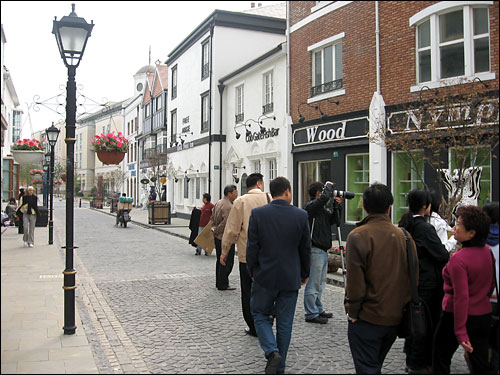 Thames Town may look exactly like an English country village, but it's actually 25 miles southwest of Shanghai. It's one of nine new towns Shanghai planners hope will relieve population pressures in the city center.
Thames Town may look exactly like an English country village, but it's actually 25 miles southwest of Shanghai. It's one of nine new towns Shanghai planners hope will relieve population pressures in the city center.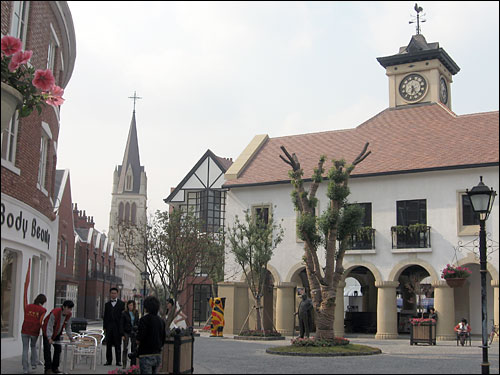 The town's market square even has its own statue of Winston Churchill.
The town's market square even has its own statue of Winston Churchill. Yang Jinghui and Zi Haiying pose for wedding photographs in front of Thames Town's church.
Yang Jinghui and Zi Haiying pose for wedding photographs in front of Thames Town's church.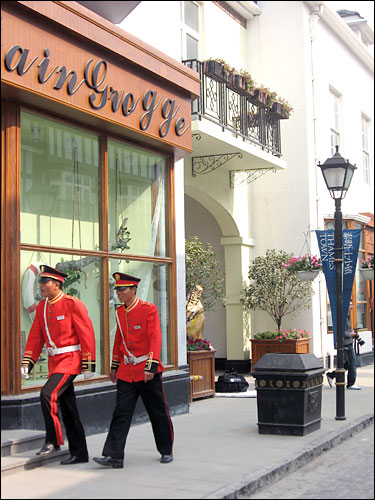 Even Thames Town's security guards have special touches to their uniforms that seem designed to evoke English pageantry.
Even Thames Town's security guards have special touches to their uniforms that seem designed to evoke English pageantry.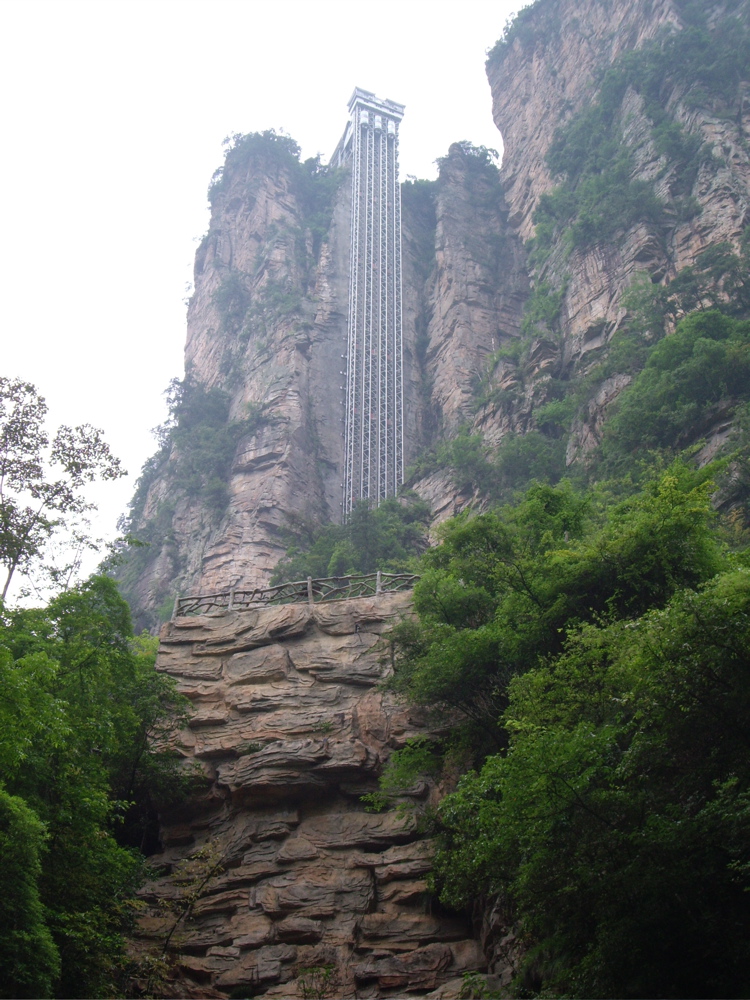





 Tianzi (Son of the Heaven) Hotel was built around 2000 or 2001 in Yanjiao developing district (燕郊开发区) of Beijing, which won Guinness World Records of the world biggest image building in 2001. It is 41.6m high with the forms of three traditional Chinese gods (福禄寿, Happiess, Fortune and Longevity). This hotel is 10 stories high. The stardard room is smaller than normal ones, and ninth floor provides president suite. There is even an Peach-shape suite.
Tianzi (Son of the Heaven) Hotel was built around 2000 or 2001 in Yanjiao developing district (燕郊开发区) of Beijing, which won Guinness World Records of the world biggest image building in 2001. It is 41.6m high with the forms of three traditional Chinese gods (福禄寿, Happiess, Fortune and Longevity). This hotel is 10 stories high. The stardard room is smaller than normal ones, and ninth floor provides president suite. There is even an Peach-shape suite.

 Xiayi, Henan Province 河南夏邑曹集乡
Xiayi, Henan Province 河南夏邑曹集乡 Linfen, Shanxi Province 山西临汾
Linfen, Shanxi Province 山西临汾 Zhongxian, Chongqing City 重庆市忠县黄金镇
Zhongxian, Chongqing City 重庆市忠县黄金镇 Huaxi Village, Jiangsu Province 江苏华西村
Huaxi Village, Jiangsu Province 江苏华西村
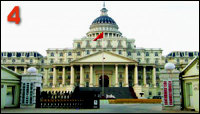 This governmental building is in Yingquan District of Fuyang, Anhui Province安徽阜阳颍泉区, which costs tens of million Chinese Yuan. It is "Western-style". The average annual income of local people is 2000 Yuan.
This governmental building is in Yingquan District of Fuyang, Anhui Province安徽阜阳颍泉区, which costs tens of million Chinese Yuan. It is "Western-style". The average annual income of local people is 2000 Yuan.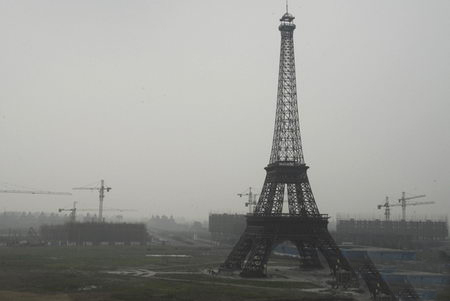
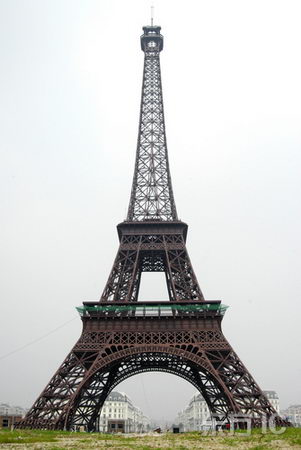



 Forbidden City, Beijing
Forbidden City, Beijing Forbidden City, Hengdian World Studio, Zhejiang Province (the mountains are kind of a giveaway)
Forbidden City, Hengdian World Studio, Zhejiang Province (the mountains are kind of a giveaway) Another view of the Forbidden City, Beijing
Another view of the Forbidden City, Beijing and the ersatz Forbidden City, Hengdian World Studio, Zhejiang Province
and the ersatz Forbidden City, Hengdian World Studio, Zhejiang Province 




 There is an "Erechtheion Temple" in West Economical Developing District of Zhengzhou, which was built around 1994 while now it's abandoned. Its program is uncertain and could be for entertainment, such as a club, a public bath house, etc. It's reported that it's from Erechtheion's "orignal" drawings.
There is an "Erechtheion Temple" in West Economical Developing District of Zhengzhou, which was built around 1994 while now it's abandoned. Its program is uncertain and could be for entertainment, such as a club, a public bath house, etc. It's reported that it's from Erechtheion's "orignal" drawings. Erechtheion Temple in Greece
Erechtheion Temple in Greece